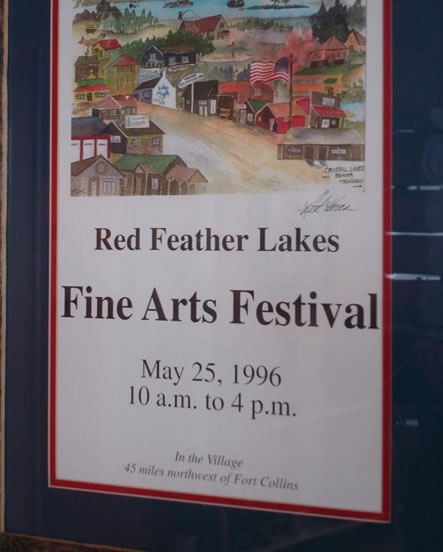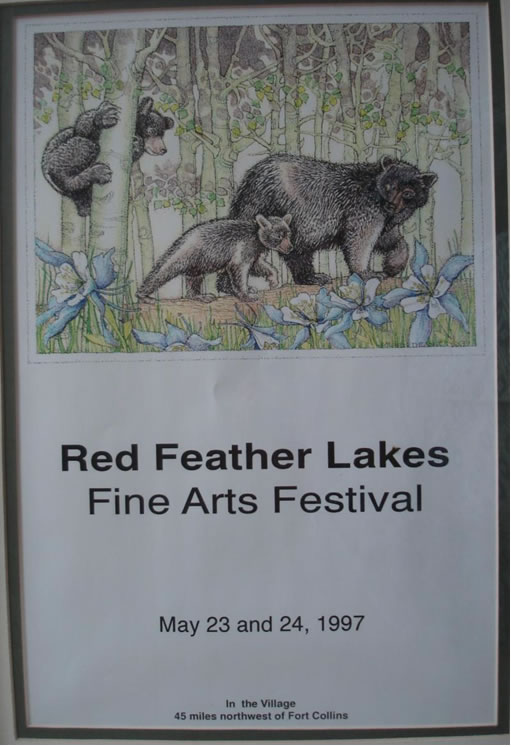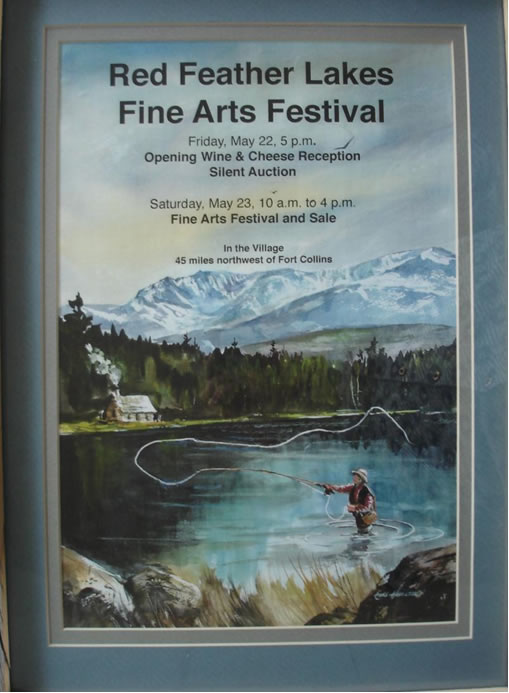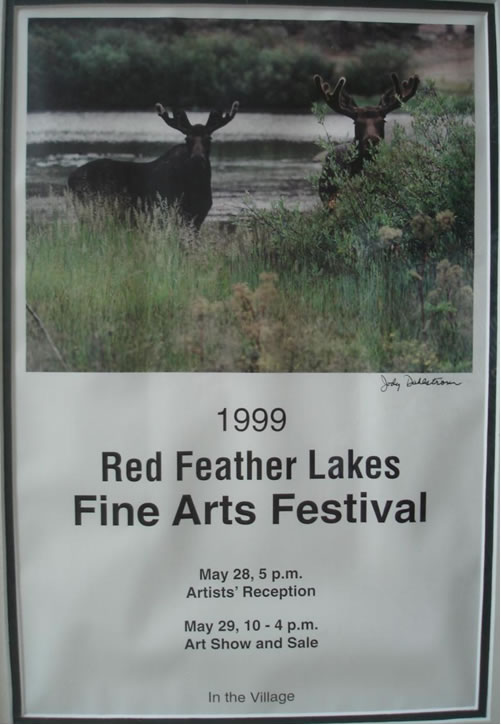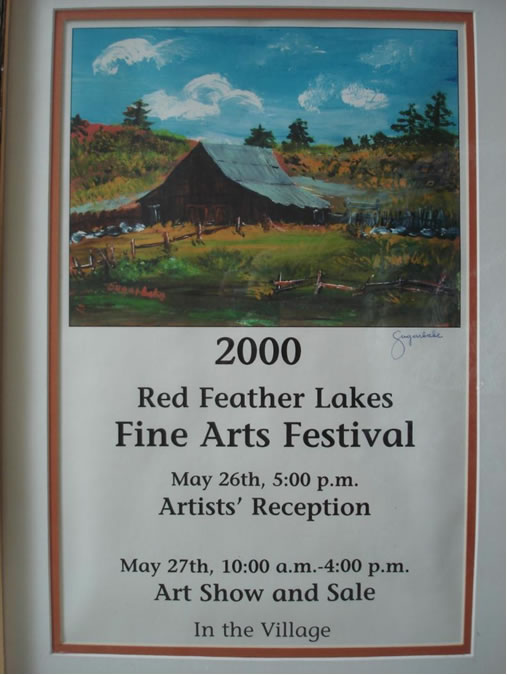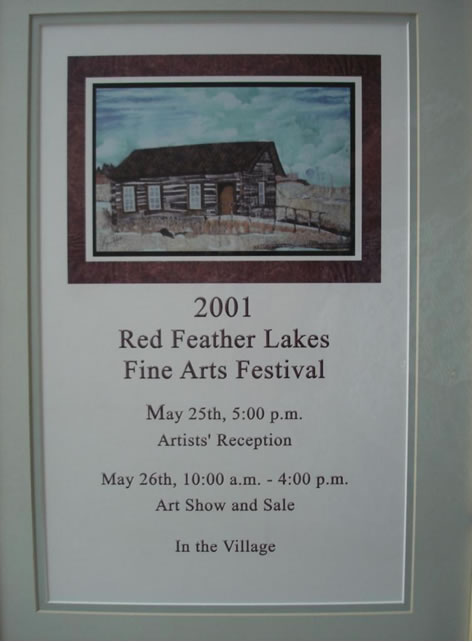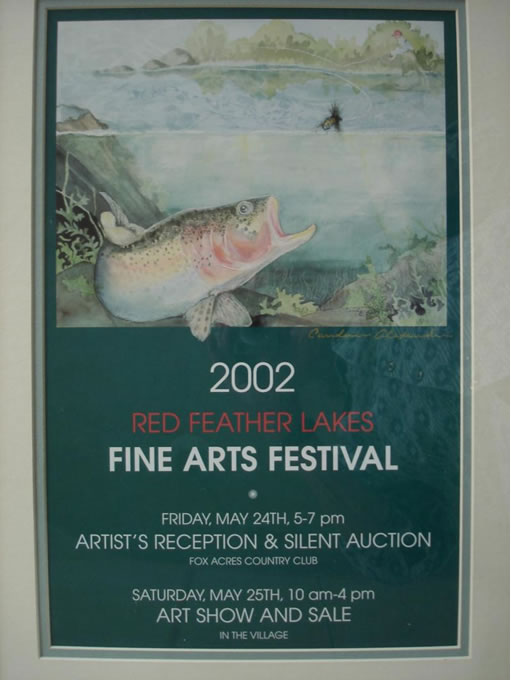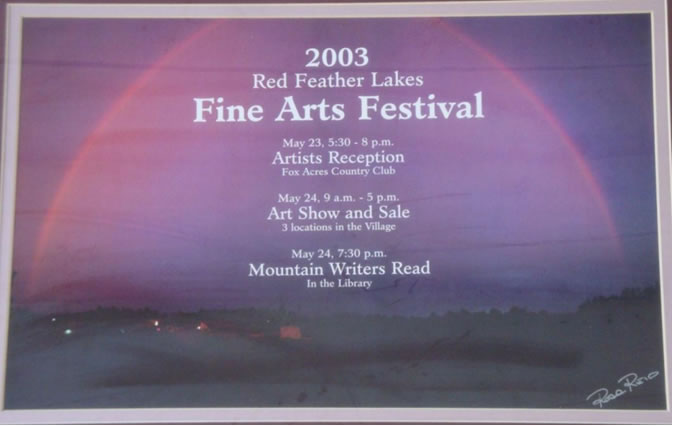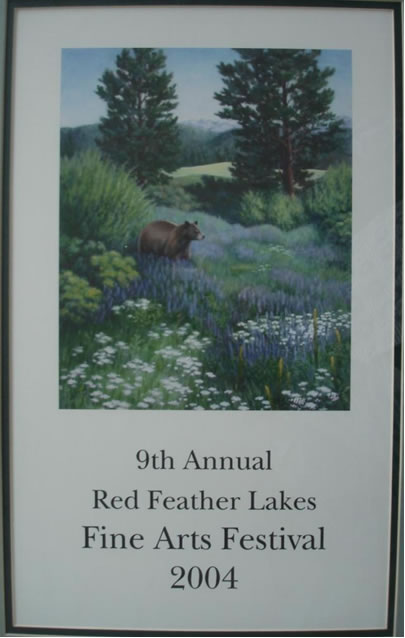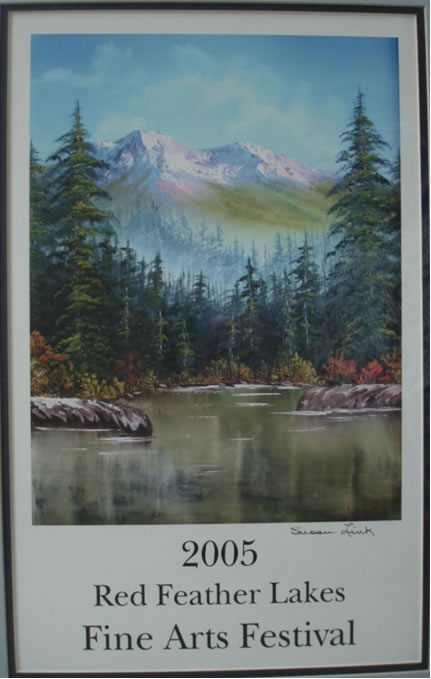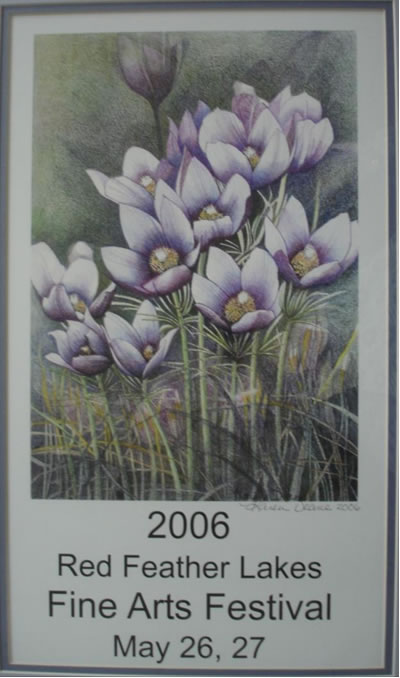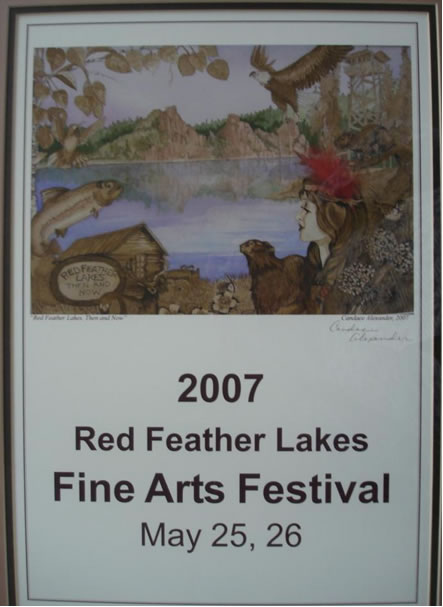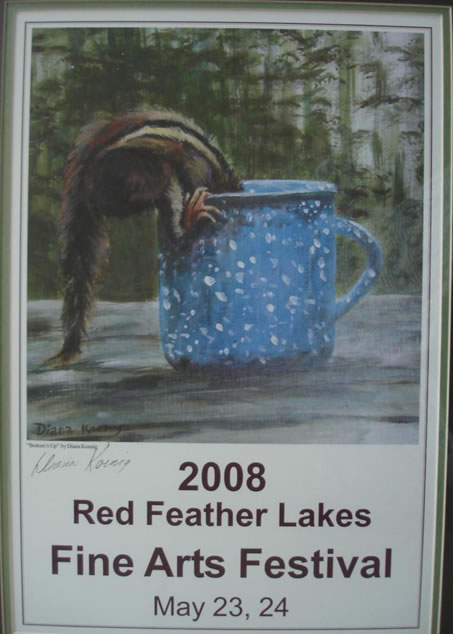Interview with Marilyn Colter
June 10, 2013 in Paonia, CO
History of the Red Feather Lakes Fine Arts Festival, 1996 to 2008
Interview and transcription by Linda Bell
[Interview available as PDF file]
Table of Contents:
- History of the Red Feather Lakes Fine Arts Festival, 1996 to 2008
- Posters produced for the Fine Arts Festivals
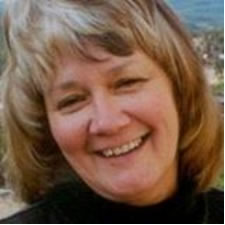
Before moving to Paonia, CO, Marilyn Colter was the Red Feather Lakes Library Director from 1995 to 2005, after which she operated Mountain Crafts Gallery from 2005 to 2010.
History of the Red Feather Lakes Fine Arts Festival, 1996 to 2008
The Fine Arts Fair started actually with a conversation between Linda Gorton, Ruth Kevan, myself and Jody Dahlstrom. They said they really wanted to raise some money for some organizations, and they were particularly interested in the Red Feather Historical Society. Ruth spoke up and said, “Why can’t we split it because there are two of us from the library here and two of you that are from the Historical Society. Why don’t we work on something to get money for both those organizations?”
We got together and invited some other people to come in; we talked to – oh, I’m going to forget names here – we talked to Ross Reid and Debra Hawkins. We invited a few other people. For the initial (Fine Arts Festival) we were involved mostly with Jody and Linda, I think, Ross, Vivian Gilbert, myself and Ruth Kevan.
We invited our little water-color society to participate and we came up with the poster idea at that point. The first poster … I don’t know if we put that one out for public reaction, and had people vote on it. I think that started with a later one.
We came up with the poster. We put it out there. We worked really hard. Jody and Linda got posters up all over Poudre Canyon and into Fort Collins. The poster advertised the Fine Arts Festival.
Every artist that was going to be appearing in the Festival, in the show and in the sale, had to donate a piece of their work (to the silent auction). Everyone was very generous. They would do large pieces, they would do interesting pieces.
The second year we got to thinking, well who are we to decide (on the poster)? And someone I’m sure had complained, you know how that is… . “You guys are making all the decisions.” It’s hard to put on a festival of that size that was growing like it was. That was just a piece of it. Everyone in the community helped.
We chose Memorial Day because it was the only holiday where there wasn’t already an organized fundraiser of some kind. It was always thought to be too early, and frankly, it probably was too early because it was almost always too cold and windy and miserable. We did use the POA and the hall indoors. It was another craft fair, but it was also a juried art show.
Stuff was pretty good at first. And we had probably enough to fill … I think we first started with the POA building and filled that. It was a very successful first event. I don’t remember how much money we made that year. But pretty good. That first (earnings) went to the Historical Society, because Linda and Jody were working really hard and it was something they started and they did a lot of the foot work.
Everyone got pretty tired. So for the next year we said, you have to help more or get off the board – we had a little board of advisors which managed the Fine Arts Festival. That was the core group. By the third time it was just the core group, and I’m talking about six people who were putting it on.
The library kind of took over the reception, the wine and cheese which was very well attended. That was probably Maryanne Lyon’s initial idea. She wasn’t part of the board but she mentioned that and she helped put it together. That took place at the library. It was very well received; we couldn’t get them “out” of the library. It started at about six and went until we threw them out, probably at about nine. It was a very happy party. But the next year we made them have tickets. They could only have so many tickets, and each ticket was for one cup of the spiked punch. That involved a liquor license for the library. That was another big thing, so we went on for several years that we had the reception in the library.
I don’t know why we got to move it, so then we did the reception at Fox Acres and boy, the first one was unbelievably good. There was a huge turn-out, fancy clothes, wonderful food, and that was backed by the Fox Acres Board. They kicked in the money to do that. The next year, I don’t know what was going on at Fox Acres, but they said no, we can’t kick in that much money again. So we had to work harder. Then we took (the reception) to the POA and members of the community brought stuff. Initially it had just been wine and cheese, but Fox Acres prepared dishes and donated them.
Bob Kevan was the one who always poured the wine, and he brought his fancy, sterling silver wine-pouring things and he reined at the table where they were pouring wine and everyone got snockered. That was a very successful time and it brought back a lot of money to the Fine Arts Festival. Those were the best years. Once we moved it away from those really extravagant kind of things, it just didn’t draw the same. People loved to go to Fox Acres. It’s a gated community and we never get to see inside. Once we got inside, it was just another gated community where people lived but the club house was very beautiful.
I don’t know which years we went about this. In the meantime we got some wonderful posters every year and lots of poster entries. Mostly they were local, but we’d get one or two from Fort Collins, usually people who had a cabin near Red Feather Lakes. Slowly it got better and better.
The last years were besieged by many things. People were not as interested any more. It wasn’t as exciting any more. Then in 2007 there was a tornado the day before in Windsor and storms in Wellington. Quite a few poles were down in the area. Half of the town didn’t have any electricity that day – in Red Feather Lakes. So we couldn’t really do a good job of serving food or creating a place for the party to go on. That was in the POA. It was just a difficult time, so the artists went home. People didn’t come up for it. Several of our artists called and said they were hit by a tornado and couldn’t come. Or just didn’t show. Or were helping friends. So we had a very small turn-out of artists and everyone was disappointed.
Then the next year we didn’t have a good turn-out of artists because no one made any money the year before. So it was just one of those things that died a sad little death. Twelve years – that’s not all bad for something like that. I wish we could have kept it going longer. But it came down that it was just Ross and me and that was all. Oh, and Vivian Gilbert but she was also tired. She was in the water-color group and on the library board. She was a big supporter. She stayed for quite a while and shepherded it very effectively. Three people can’t put on a festival of that size. Ross and I were both just not in a position where we felt we could put that much energy into it. So it died.
The artists donated a piece of art for the silent auction in order to show at the festival. That’s where the money was earned. In addition, people in the community would donate artistic items for auction or services by offering a certificate. The first year there was a donation someone got from one of the breweries and there was a huge basket of all kinds of different beers and wines. Sometimes there were special food items. The artists were the ones being honored at the reception but there were a lot of other things that went into the silent auction to make more money.
The board once thought about spreading it out to the school, and it turned into one of those things where other people complained because they didn’t get benefit. The festival earnings toggled between the Historical Society and the Library Friends. Oh, I think we were going to try and fund a new school playground. And we also did a bathroom for the POA building one year. I think it benefited the POA only that one year. We paid for the remodeling to make one of the bathrooms handicapped accessible.
Unfortunately, animosity was created when we started doing that. So we quit doing it – it wasn’t worth it to be fighting over that. It wasn’t that much money. The festival usually earned about fifteen hundred dollars, not fifty thousand. It wasn’t a very effective way to manage the money, so we went back to just the two beneficiaries.
It was an awful lot of fun, especially in the beginning. Everybody just loved it so much. They were also so happy to come. And it attracted beautiful art work from many talented artists. After a while, there were just too many of the same artists and we couldn’t refresh them.
I think everybody enjoyed voting for the poster winner. They weren’t altogether altruistic about it either. Some people would put in, say 20 votes, for somebody. But somehow it all evened out and there was a good poster. It was silly. Sometimes it was a popularity contest. I think we should have gone back to the festival board getting to choose, because it didn’t seem fair that people were cheating.
It was an innovative thing to have happen back in those days. It would have been nice to have kept it going. A lot of the artists were disappointed. But it just got to be the same thing over and over, the same artists. You need new energy behind something like that to keep it going. Here are the names of those who served on the Festival Board over the years; Pat Mathews Clemens, Debra Hawkins, Russ and Dorothy Wakefield, Vivian Gilbert, Bill Gilbert, Ross Reid, Ruth Kevan, Jody Dahlstrom and Linda Gorton. Personally I loved the Festival and had lots of ideas about how to reinvigorate it. It was really a good thing for our community.
***
Posters produced for the Fine Arts Festivals, 1996-2008
